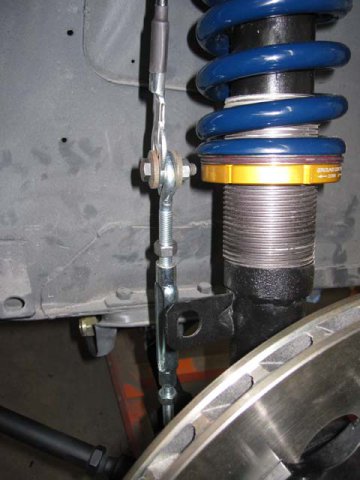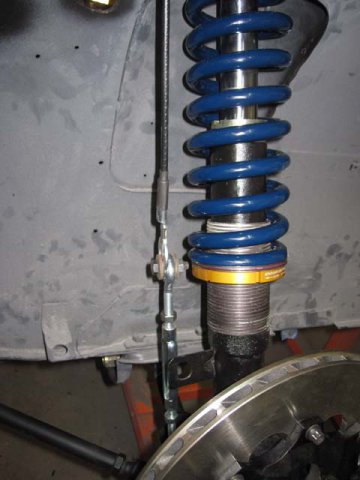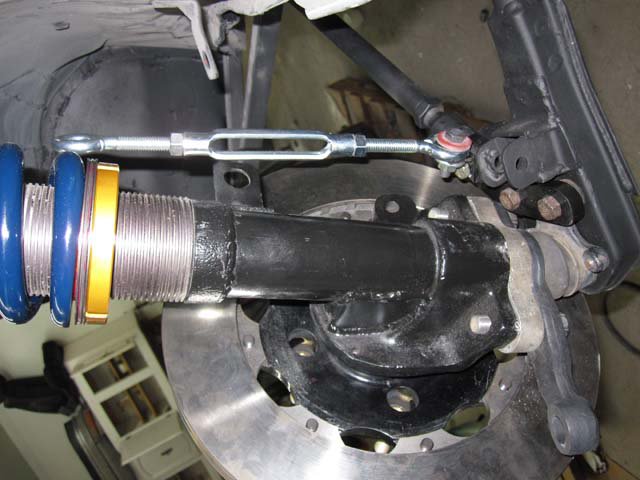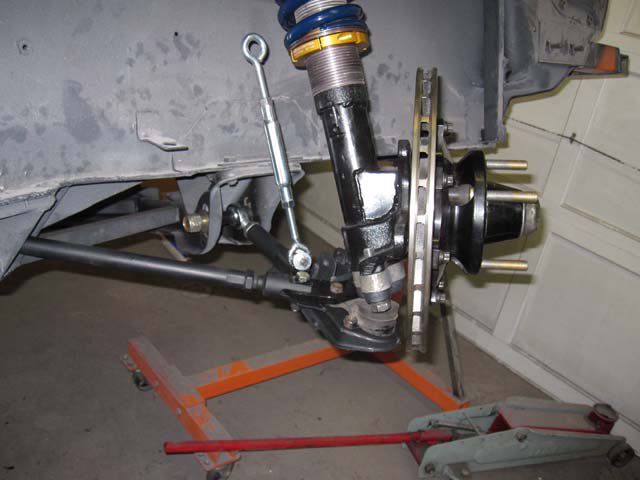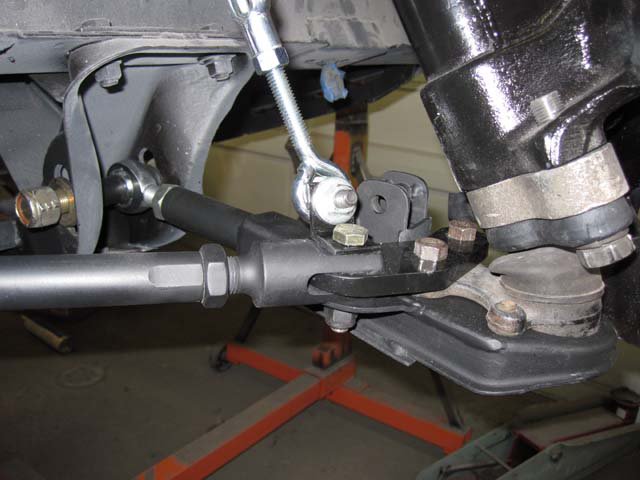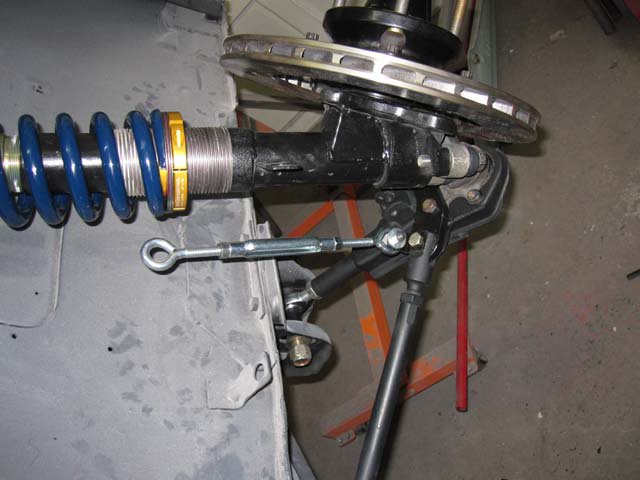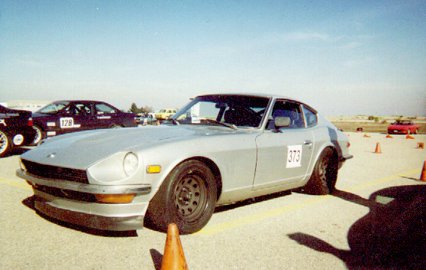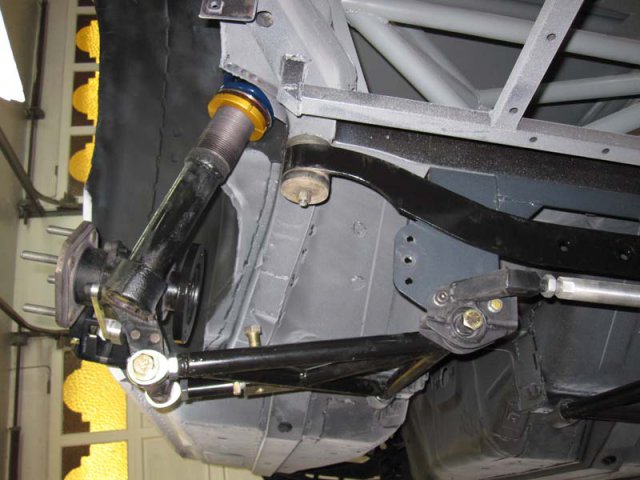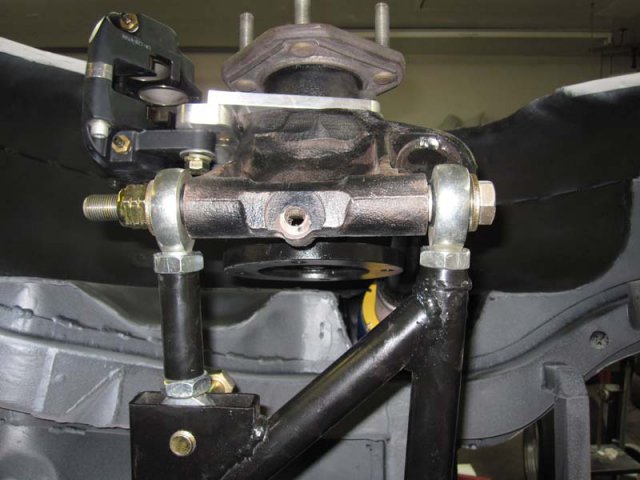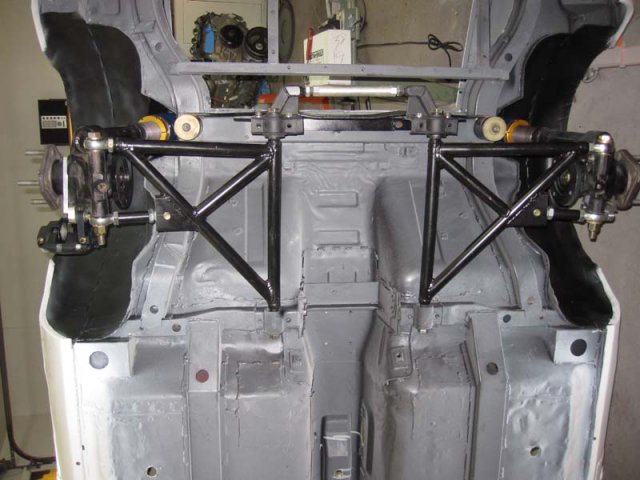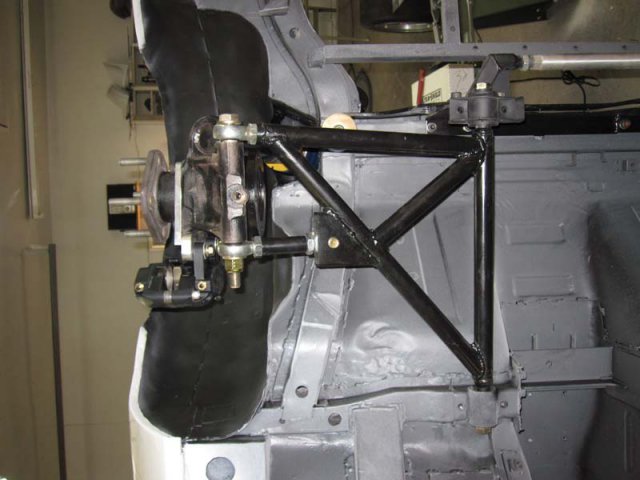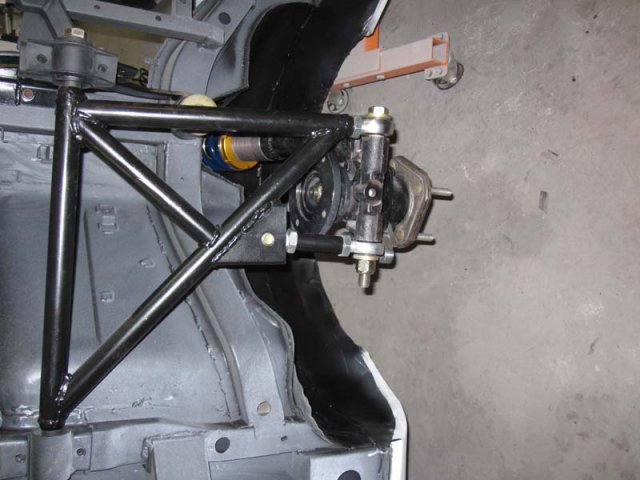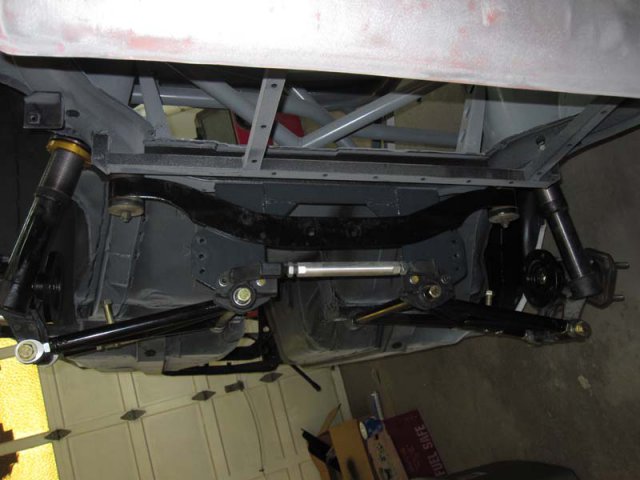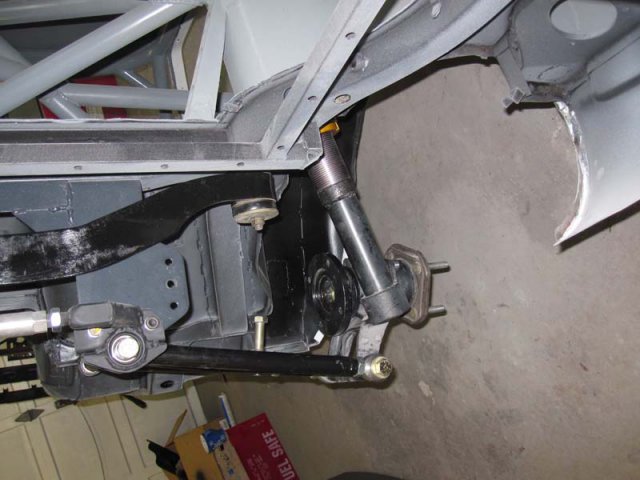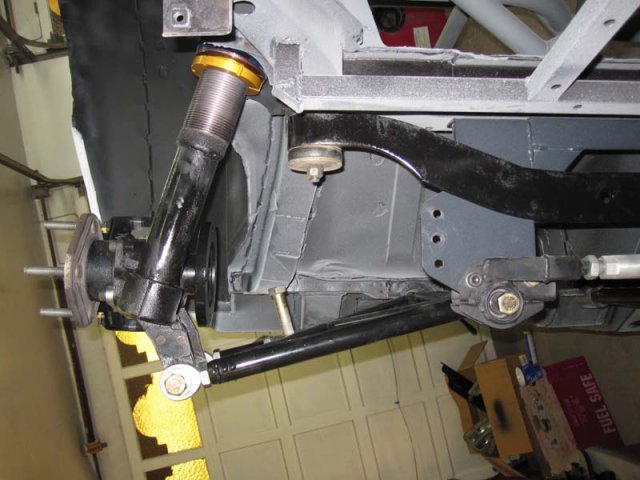-
Posts
13742 -
Joined
-
Last visited
-
Days Won
67
Content Type
Profiles
Forums
Blogs
Events
Gallery
Downloads
Store
Everything posted by JMortensen
-
Put the whole droop limiter together and found that the limiter had to bend inward to clear the inner fender well/strut area. Bent it to clear and now there is about 1/4" between the bolt and the coilover adjuster. I can flip the bolt around and get maybe 1/2", but it's still looking pretty tight. Anchored the cables at the top as far inward of the camber plate as possible, just to alleviate any issues with adjusting the plate into the cable. I'm thinking a slightly longer cable would work, there is still plenty of adjustment in the turnbuckle, so I could probably get a cable that is an inch or two longer. At this point I have to compress the suspension a bit just to fit everything together, but I don't think I'm going to be running the coilovers way up at the top of their adjustment so I don't anticipate this being a problem. Pics of the whole thing installed:
-
Working on final assembly of my suspension and realized that I never got around to making droop limiters. I had purchased some small, lightweight cable and a couple ends, but it turned out that in order to get all the parts I would spend about $40 per corner just for the fittings. Cary suggested that I use tailgate stay cables that you find in the Help! section of the auto parts store. Then I was left looking for turnbuckles. Looking at mcmaster.com it seems about the cheapest you can find is in the $15 each range for something that would work with the relatively large cables, so I wanted to find something cheaper. Went to buy some hardware at Tacoma screw and they had some cheap 5/16" thread turnbuckles for $2 each. I figure I'll have about $15 per corner into the whole thing at this cost. Starting in the front I took a piece of angle stock and drilled it to attach to the TC rod and to the eyelet on the turnbuckle. I had to bend the angle iron so that the turnbuckle didn't interfere with the strut. I really don't like this long, heavy turnbuckle, but I'm more interested in getting the thing running, I can always redo this later. I did check for clearance with the caliper and also the wheel, and looks like it is OK. I'm a bit concerned that the turnbuckle may hit the inner fender well at full compression, I may have to pull the spring off to check that out. Anyway, looking for feedback from Cary and Dan and anyone else who has done this or has suggestions/criticisms.
-
At CMP with the 13 inch floating rotor set up
JMortensen replied to mark's topic in Brakes, Wheels, Suspension and Chassis
WOW!!! Good thing they saw that before you got out on track again. -
???
-
Front lower control arms and new subframe
JMortensen replied to zclubhouse's topic in Brakes, Wheels, Suspension and Chassis
1" sway bar has an effective rate of 300-something lbs/in. Its in Dan's (74_5.0L_Z) sticky thread in this forum. Attaching the sway bar to the strut housing is a good way to go if you can figure it all out. I looked at it for about 5 minutes and then made a more traditional sway bar setup. -
Like I said before, that may or may not be true based on inflation pressures, sidewall stiffness, etc. Note the Z running 8's on the 15" rims, not the 18's.
-
Which is still slower than having the smaller diameter wheels and fixing the gearing issue.
-
Let's argue the technical bits, or stop. I know I have the tech on my side. I've been wrong and admitted it here plenty of times. Show me I'm wrong again. Please. Pretty please. I love to be proven wrong, because I learn from it. On this one I am pretty sure I'm right though. The faster to 50 mph thing has to be a gearing issue. Give me a physics based reason why a heavier wheel with higher PMOI will accelerate faster than a smaller diameter light wheel, and I'll be happy to relent and admit that I've been wrong the whole time. Don't waste too much time looking for one though. Here is my physics based reason for believing that lighter wheels with smaller PMOI accelerate faster: From http://en.allexperts.com/q/Physics-1358/2009/12/Circular-motion-concepts.htm The faster on the course thing is an apples to oranges comparison, because of the increased width of the tires. If you want to say that 18x12 wheels might handle better than 15x7's on an autox course, I'd happily concede that point. I have no problem accepting large diameter wheels on modern performance cars, because they're generally heavier, and they have bigger brakes than our 1970's cars do. Again, that is the best reason to put large wheels on a car; to fit larger brakes. Modern cars are designed at the outset to have larger wheels so they don't have the same suspension issues that our Z's do when you put them on. You're arguing the equivalent of "Heavier sportscars are faster because modern sportscars are heavy." It's not a good logical argument. Modern sportscars may be a lot faster than 70's sportscars, but it certainly isn't because they're heavier.
-
Aesthetics is subjective. If you want 18's because you like the look then go for it. Just don't try to argue that there are no downsides to them or that they'll make your car faster, because in the vast majority of cases they won't. Nobody is starting "Look at these stupid ass 18's on this Z" threads. We're just responding to erroneous claims in threads about 18 inch wheels, that's all. If the OP had bothered to search before posting this thread wouldn't even exist. The topic has been beat to death here and in other threads. Let's move along, shall we?
-
Faster on an autox because the extra 160mm tread width. Faster to 50 probably because it was overgeared prior to the wheel swap. I can't think of another reason a heavier wheel with a higher PMOI would make you faster.
-
From your link: 1. There is SOME truth to the idea that a larger diameter wheel has a longer contact patch and will therefore accelerate and stop better. I say some because inflating the tire to a higher pressure reduces the size of the contact patch and the smaller sidewall hinders the ability of the tire to conform to the road, and the lower the profile of the tire, the higher the pressure needs to be and the less flexible the tire is. 2. This is the real reason for people running bigger rims on their Z cars. You've said so yourself in the past. 3. Assumes plus sizing, where you run a shorter sidewall to get the same OD. If you run a lower profile tire on the smaller tire, then 3 is not necessarily true. 4. The Ferrari has 14" rotors, hence the larger rims. If you think that Ferrari doesn't put 20's on the back for style points, I can't help you.
-
I get you. He made a blantant error substituting diameter for radius, but the tire diameter is still 24.8 for a 285/30/18 as an example, and the Kuhmo that you referenced weighs 25 lbs, so that is more than half of the tire/wheel weight. I'd expect the center of mass to be out at the 11-11.5 inch mark.
-
You must be running those helium infused tires then. We were talking about the center of mass of the tire and wheel, right?
-
Are you positive on that? I haven't dissected a rim to measure, but I think the majority of the rim weight is the outer part from the drop center out, not the spokes and hub. I'm going to assume that the tire is 1/2 or more of the total wheel assembly, and again I haven't cut up a tire to measure the tread vs sidewall weights, but I would guess the majority of that being the tread which is the OD, I think this is more likely to be true on an 18 with a short sidewall. So there is a lot of mass right out at the OD. I would expect if the diameter is 25.5 or 26 the center of mass would be more in the 11" range. On a 23" tall tire with a taller sidewall, maybe 9". That's pure SWAG, so it would be interesting to see actual calculations if you have them. That is pretty light. Still even an equal weight with a higher PMOI is going to be harder to speed up or slow down. I understand that car hauls ass and I'm not trying to say it doesn't, only that it might haul more measurably more ass with the Hoosiers on it.
-
Yet another Rear control arm design
JMortensen replied to tholt's topic in Brakes, Wheels, Suspension and Chassis
They are 3/4" rod ends. Hopefully they hold up... -
I have no idea what you are talking about. Scaling a car is about getting the cross weights as even as possible. Setting the height 1" higher or lower doesn't change the cross weights. Setting the right front 1/4" higher than the left front will. NASCAR is the most boring racing there is. The cars are not built stupidly or by stupid people though, and if you think that they are then I suggest you do some research and maybe read a good magazine on the subject like Stock Car Engineering. You might find out you're really very very extremely wrong. The problem with large diameter wheels, and I've said this many times here before so I'll state it briefly and then let you guys search for more if you want to know and ignore me if you don't, is that they don't "look right" when you just stick the wheels on. You have to make the gap between the fender and the wheel very small to get the look right, and THAT is where the problem lies. Lower the car far enough and the bumpsteer gets scary. I know because I had a car that would do emergency lane change type manuevers without any input on the steering wheel due to bumpsteer on my very lowered Z car. It's true that you CAN modify the suspension to handle well, but I've only ever seen a handful of people do that. The rest just slam it and drive around thinking it looks cool and they've improved the handling. I'm biased against big wheels, because I hate putting more weight on the car, and I hate it most when that weight is rotating weight. It makes the car slower, and makes the brakes less effective, and the suspension work harder. If you don't want to take my word for it on the slammed z thing, take it from johnc who has built one of the fastest Z cars on the west coast and ran it a lot higher than your typical slammed Z and has repeatedly told people that if they want to go faster they should raise the car up. Take it from blueovalz who went to great lengths to fix the rear roll center issues on his car. Or don't. Here's mine which was too low for the mods at the time this picture was taken:
-
I think you're looking at it wrong. Lower a Z too far and all sorts of crazy crap starts happening to the suspension. Roll centers underground, bumpsteer off the charts, etc. Take a look at some of the stuff that people here have done to fix those issues. Blueovalz's car comes to mind, with his extended length rear struts that were made to get the rear roll center above ground, because his 17's didn't look right until the car was so low that the roll center was well underground. My car would be another example, with slotted crossmember and TC rod pivots so that I can tune out bumpsteer, raise the roll center and get rid of whatever pro-dive might be incurred by running the TC rods at the stock pivot point with the car really low. There's a LOT more to it than just "Lowering the car is for performance gains."
-
Yet another Rear control arm design
JMortensen replied to tholt's topic in Brakes, Wheels, Suspension and Chassis
Back to this about 14 months later. Got these installed and checked them out for fitment, etc. Everything looks good except the rear rod end was very close to binding against the strut housing. I suppose I could have radiused the end of the strut housing with a grinder, but instead I grabbed a couple 1/8" bumpsteer spacers I had laying around and added them between the rear rod end and the strut housing. With them in place everything looks peachy, and due to the freedom of motion in the toe link the addition of the spacer shouldn't be a problem. Working on installing the whole suspension, doing a final once over on it, and then I'll be plumbing fuel and brakes. -
S130 Suspension Tech
JMortensen replied to Smokescreen's topic in Brakes, Wheels, Suspension, and Chassis
I got a real common sense explanation of the relationship between shock valving and ride the other day. If you've ever pushed on the suspension of a car that had no shocks or blown shocks, you've felt that the springs alone can be pushed fairly easily. Add the shocks, and now it takes a LOT more effort to get that chassis to move. The shocks make more difference than the springs for sure. -
I've got 15" rims that clear the 12.2" Arizona Z style Wilwoods. If you go with 13" brakes like MM offers, I think 16s fit, for sure a 17 would have those covered. "Big" brakes do not require rims that large.
-
Wait a minute. He said the PINION is too big. Makes me think the end of the teeth on the pinion are hitting the LSD. The LSD doesn't taper down like the open carrier does and a 3.15 gearset will have a larger OD. If that's the case I'd grind on the pinion gear. Sounds extreme, but it's not the end of the world. Some info about grinding gears for clearance or repair here: http://www.ringpinion.com/TipArchives.aspx
-
.040 too big in what way? Is the pilot where the ring gear slips on too large in diameter? Could be machined down. Too tall in step? Could also be machined 1mm. If you set the carrier down the left side bearing so that you can see where the ring gear bolts on, then measure from the bench to the surface where the ring gear bolts to, that is the step. FWIW most carriers have a press fit with the ring gear on the LSD, the Nissans don't seem to at all. I'd suggest that if you have a pilot that is too large you machine it for a press fit.
-
Type in "18s" into the search box. Been discussed more than once.
-
Did they tell you how an open would work if the LSD wouldn't? Sounds a bit weird, unless the gearset comes with it's own carrier that has a different offset.
-
Doesn't the S130 have a coilover setup from the factory? I think (correct me if I'm wrong John) that what John is getting at is that the bars that attach to the hoop and back (backstays) should be attached to the strut towers if the spring loads hit there. I would argue that it doesn't matter if it is spring and shock loads or just shock loads, the backstays should attach to the tower regardless. In a separate spring and shock setup, more load gets transferred through the shock than the spring.

